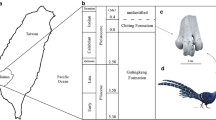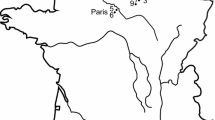Abstract
The first Cenozoic avian remains from Venezuela are described. The material comprises an associated right tarsometatarsus and tibiotarsus from the earliest Pliocene of the Codore Formation, northwestern Venezuela. The fossil-bearing horizon represents a deltaic paleoenvironment. The elements are long and narrow, and the presence of a circular incisura intercondylaris bordered proximally by a prominent and centrally-situated tuberculum m. tibialis anticus on the tibiotarsus, allows confident referral to the Ciconiidae (storks). The elements are a close match in morphology and size to the extantJabiru mycteria (Jabiru Stork), although the presence on the distal tibiotarsus of a well-defined caudal sulcus, a narrower sulcus extensorius and shallower angled pons supratendineus, and on the tarsometatarsus of a narrower and deeper sulcus on the plantar surface and a less prominent ridge laterally bordering the fossa supratrochlearis plantaris indicate that this is a new species,Jabiru codorensis n. sp.Jabiru mycteria, the only living species, still occurs in Venezuela, where it is found mostly in grassy wetlands. These specimens represent the first fossil record ofJabiru, as well as the first pre-Pleistocene record of fossil birds from Venezuela.
Kurzfassung
Die ersten fossilen Nachweise von Vögeln aus dem Tertiär Venezuelas werden beschrieben. Bei dem Material handelt es sich um einen assoziierten rechten Tarsometatarsus und Tibiotarsus aus der unterpliozänen Codore-Formation, nordwestliches Venezuela. Die fossilführenden Horizonte entsprechen einem deltaischen Paläoenvironment. Die Fossilelemente sind lang und dünn. Das Vorhandensein einer kreisförmigen Incisura intercondylaris, an welche proximal ein prominenter, zentraler Tuberculum m. tibialis anticus auf dem Tibiotarsus grenzt, ermöglicht eine zuverlässige Einordnung dieser Fossilien in die Ciconiidae (Störche). Die Elemente sind morphologisch und in ihrer Größe der lebenden ArtJabiru mycteria (Jabiru-Storch) sehr ähnlich, obwohl das Vorhandensein eines klar abgegrenzten kaudalen Sulcus am distalen Tibiotarsus, eines schmaleren Sulcus extensorius und flacheren abgewinkelten Pons supratendineus des Tibiotarsus, sowie eines schmaleren und tieferen Sulcus auf der plantaren Oberfläche des Tarsometatarsus und einer weniger prominent ausgebildeten Kante, welche lateral die Fossa supratrochlearis plantaris begrenzt, am Tarsometatarsus auf eine neue Art,Jabiru codorensis n. sp., hindeuten.Jabiru mycteria, die einzige lebende Art der Gattung, kommt heute noch in Venezuela vor, wo sie hauptsächlich in grasbewachsenen Feuchtgebieten zu finden ist. Die hier beschriebenen Fossilien sind sowohl die ersten fossilen Nachweise vonJabiru als auch die ersten präpleistozänen Nachweise fossiler Vögel aus Venezuela.
Similar content being viewed by others
References
Aguilera, O.A. 2004. Tesoros Paleontolögicos de Venezuela. Urumaco Patrimonio Natural de la Humanidad. — 148 p., Caracas (Editorial Arte).
Alvarenga, H.M.F. &Guilherme, E. 2003. The anhingas (Aves: Anhingidae) from the Upper Tertiary (Miocene-Pliocene) of southwestern Amazonia. — Journal of Vertebrate Paleontology23: 614–621.
Alvarenga, H.M.F. &Höfling, E. 2003. Systematic revision of the Phorusrhacidae (Aves, Ralliformes). — Papéis Avulsos de Zoologia43: 55–91.
Baumel, J.J. &Witmer, L.M. 1993. Osteologia. — In:Baumel, J.J.;King, A.S.;Breazile, J.E.;Evans, H.E. &Vanden Berge, J. C, eds., Handbook of Avian Anatomy: Nomina Anatomica Avium: 45–132, Cambridge MA (Publications of the Nuttall Ornithological Club).
Becker, J.J. 1987. Neogene avian localities of North America. — 171 p., Washington DC (Smithsonian Institution Press).
Boles, W.E. 2005. A review of the Australian fossil storks of the genusCiconia (Aves: Ciconiidae), with the description of a new species. — Records of the Australian Museum57: 165–178.
Brodkorb, P. 1961. Birds from the Pliocene of Juntura, Oregon. — Florida Scientist24: 169–184.
Brunet, M. & Brunet, M.P.F.T. 2000. Chad: Discovery of a vertebrate fauna close to the Mio-Pliocene boundary. — Journal of Vertebrate Paleontology20: 205–209.
Canterbury, G.E.;Martin, T.E.;Petit, D.R.;Petit, L.J. &Bradford, D.F. 2000. Bird communities and habitat as ecological indicators of forest condition in regional monitoring. — Conservation Biology14: 544–558.
Carlini, A.A.;Scillato-Yané, G.J. &Sänchez, R. 2006. New Mylodontoidea (Xenarthra, Phyllophaga) from the middle Miocene-Pliocene of Venezuela. — Journal of Systematic Palaeontology4: 255–267.
Cheneval, J. 1984.Grallavis edwardsi new genus, new combination: new fossil genus of birds (Ciconiiformes) from the Aquitanian deposits of St Gerard le Puy, Allier, France. — Bulletin Mensuel de la Société Linneenne de Lyon53: 43–60.
Cheneval, J. 1993. L’Avifaune Mio-Pliocène de la Formation Pisco (Pérou). Étude préliminaire. — Documents des Laboratoires de Géologie Lyon125: 85–95.
Feduccia, A. 1973. Fossil birds from the Late Pleistocene Ingleside Fauna, San Patricio County, Texas. — The Condor75: 243–244.
Garrod, A.H. 1874. On certain muscles of birds and their value in Classification. Pt. II. — Proceedings of the Zoological Society of London1873: 111–123.
Haarhopp, P.J. 1988. A new fossil stork (Aves, Ciconiidae) from the late Tertiary of Lanfebaanweg, South Africa. — Annals of the South African Museum97: 297–313.
Hellmayr, C.E. 1906. Critical notes on the types of little-known species of neotropical birds. — Novitates Zoologicae13: 305–352.
Hill, A. &Walker, A.C. 1979. A fossil marabou (Aves, Ciconiidae) from the Miocene Ngorora Formation, Baringo District, Kenya. — Netherlands Journal of Zoology29: 215–220.
Hilty, S.L. 2003. Birds of Venezuela. — 928 p., London (Christopher Helm).
Howard, H. 1942. A review of the American fossil storks. — Carnegie Institute of Washington Publication530: 187–203.
Huntley, B.;Collingham, Y.C.;Green, R.E.;Hilton, G.M.;Rahbek, C. &Willis, S.G. 2006. Potential impacts of climatic change upon geographical distributions of birds. — Ibis148: 8–28.
Kahl, M.P. 1971. Observations on the Jabiru and Maguari Storks in Argentina, 1969. — The Condor73: 220–229.
Kahl, M.P. 1973. Comparative Ethology of the Ciconiidae. Part 6. The Blacknecked, Saddlebill, and Jabiru Storks (GeneraXenorhynchus, Ephippiorhynchus, andJabiru). — The Condor75: 17–27.
Linares, O. 2004. Bioestratigrafia de la fauna de mamiferos de las formaciones Socorro, Urumaco y Codore (Mioceno medio-Plioceno temprano) de la region de Urumaco, Falcon, Venezuela. — Paleobiologia Neotropical, Contribuciones Ocasionales Editada por el Laboratorio de Paleobiología de la Universidad Simón Bolívar1: 1–26.
Linnaeus, C. 1758. Systema Naturae per regna tria naturae, secundum classes, ordines, genera, species, cum characteribus, differentiis, synonymis, locis. 10th ed. — 824 p., Stockholm (Holmiae: Laurentii Salvii).
Mayr, E. &Cottrell, G.W. 1979. Check-list of birds of the world. Vol. 1. 2nd ed., Cambridge MA (Museum of Comparative Zoology).
Miller, L. 1932. The Pleistocene storks of California. — The Condor34: 212–216.
Miller, E.R.;Rasmussen, D.T. &Simons, E.L. 1997. Fossil storks (Ciconiidae) from the Late Eocene and Early Miocene of Egypt. — Ostrich68: 23–26.
Ministerio de Energía y Minas. 1997. Léxico Estratigräfico de Venezuela Tomo 2. — Boletín de Geología Publicaciön Especial12: 1–828.
Olson, S.L. 1976.Alexander Wetmore and the study of fossil birds. — In:Olson, S.L., ed., Collected papers in avian paleontology honouring the 90th birthday ofAlexander Wetmore. — Smithsonian Contributions to Paleobiology27: xi-xvi.
Olson, S.L. 1985a. The fossil record of birds. — In:Farner, D.S.;King, J.R. &Parkes, K.C., eds., Avian Biology8: 79–238, New York (Academic Press).
Olson, S.L. 1985b. Faunal turnover in South American fossil avifaunas: the insufficiencies of the fossil record. — Evolution39: 1174–1177.
Olson, S.L. 1991. The fossil record of the genusMycteria (Ciconiidae) in North America. — The Condor93: 1004–1006.
Phillips, A.R. 1968. Geologie age ofCiconia maltha. — The Auk85: 315.
Sänchez-Villagra, M.R. &Aguilera, O.A. 2006. Neogene vertebrates from Urumaco, Falcón State, Venezuela: diversity and significance. — Journal of Systematic Palaeontology4: 213–220.
Sellards, E.H. 1916. Human remains and associated fossils from the Pleistocene of Florida. — Florida Geological Survey, 8th Annual Report, Tallahassee 121–160.
Short, L.L. 1966. A new Pliocene stork from Nebraska. — Smithsonian Miscellaneous Collections149 (9): 11.
Stattersfield, A.J.;Crosby, M.J.;Long, A.J. &Wedge, D.C. 1998. Endemic bird areas of the world — priorities for biodiversity conservation. Birdlife Conservation Series 7. — 846 p., Cambridge (Birdlife International).
Suarez, W. &Olson, S.L. 2003. New records of storks (Ciconiidae) from Quaternary asphalt deposits in Cuba. — The Condor105: 150–154.
Sundevall, C.J. 1836. Ornithologiskt System. — Kungliga Svenska Vetenskapsakademiens Handlingar1836: 43–130.
Unwin, D. 1996. The quality of the avian fossil record. — Journal of Vertebrate Paleontology16: 70A.
Vuilleumier, F. 1984. Faunal turnover and development of fossil avifaunas in South America. — Evolution38: 1384–1396.
Walsh, S.A. &Hume, J.P. 2001. A new Neogene marine avian assemblage from north-central Chile. — Journal of Vertebrate Paleontology21: 484–491.
Wetmore, A. 1928. Bones of birds from the Ciego Montero deposits of Cuba. — American Museum Novitates301: 1–5.
Wetmore, A. 1931. The avifauna of the Pleistocene in Florida. — Smithsonian Miscellaneous Collection85: 1–41.
Author information
Authors and Affiliations
Corresponding author
Rights and permissions
About this article
Cite this article
Walsh, S., Sänchez, R. The first Cenozoic fossil bird from Venezuela. Paläont. Z. 82, 105–112 (2008). https://doi.org/10.1007/BF02988402
Received:
Accepted:
Issue Date:
DOI: https://doi.org/10.1007/BF02988402




